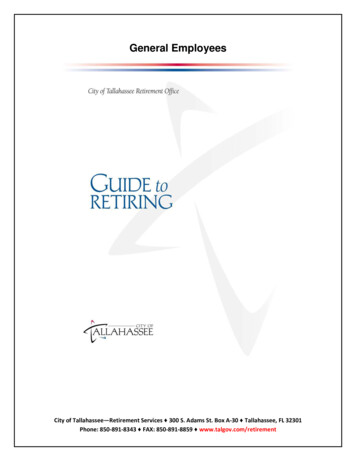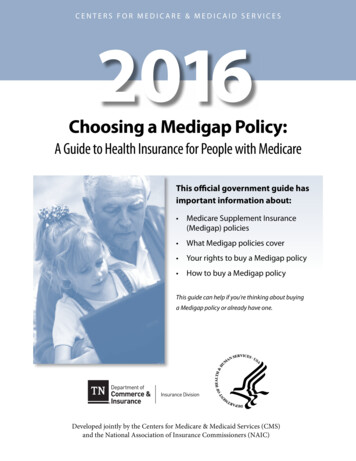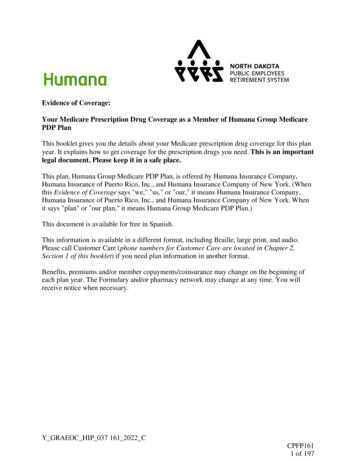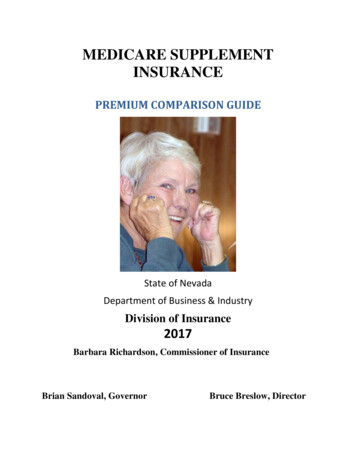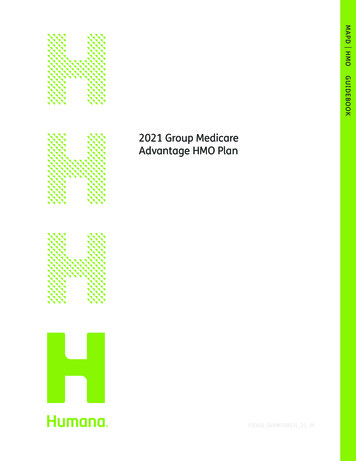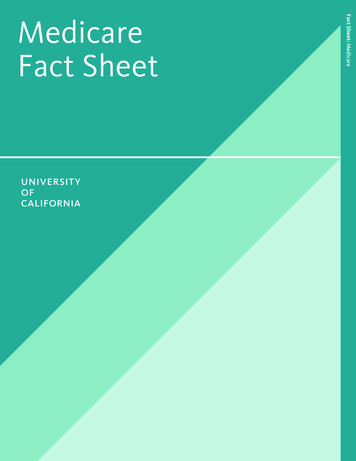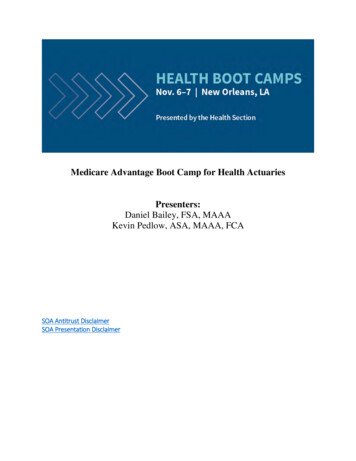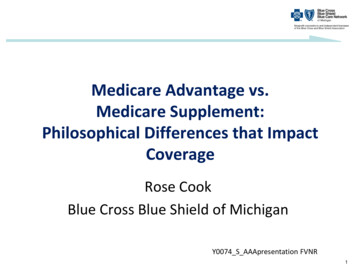
Transcription
THE OFFICIAL U.S. GOVERNMENT MEDICARE HANDBOOKMEDICARE& YOU2020
We’re improving and modernizing the way you get Medicare information. Thegoal is to provide a seamless and transparent experience to help you get theinformation you need to make good health care choices. We’re working to updatethe Medicare resources you already know and trust, and building new ones to workwith the technology you use every day.Get improved help with your Medicare choicesWe’ve made it easier to find health and drug coverage that works for you. Youcan compare ways to get your Medicare coverage and explore how differentplans work together. You can also shop and compare plans to find ones thatmeet your needs. Visit Medicare.gov/plan-compare.Find out what’s coveredThe “What’s covered” mobile app delivers reliable (Original Medicare) Part Aand Part B coverage information right on your mobile device. You can downloadit for free on both the App Store and Google Play.See estimated costs of outpatient proceduresCompare national average prices for certain procedures performed in bothhospital outpatient departments and ambulatory surgical centers. VisitMedicare.gov/procedure-price-lookup.Get easier access to your personal Medicare informationWe’ve improved MyMedicare.gov to make it easier to find what you need. Weadded new features, like the ability to print an official copy of your Medicarecard. We also connected MyMedicare.gov to Blue Button 2.0—a secure dataconnection that lets you share your health information with a growing numberof mobile apps, third party applications, health-related services, and researchprograms.Coming soon — Easily find and compare quality informationQuality information about Medicare-participating doctors, hospitals, nursinghomes, dialysis facilities, and other care providers will soon be available in oneeasy-to-use place. Compare quality ratings, cost information, and other detailsto help you choose what’s best for you. Coming in late 2019 to Medicare.gov.To stay on top of eMedicare improvements and other important news fromMedicare, sign up to get email updates at Medicare.gov.
3ContentsGet started . 4What are the parts of Medicare? . 5Your Medicare options . 6Original Medicare vs. Medicare Advantage .7–8Get the most out of Medicare . 9Index of topics . 10Section 1:Signing up for Medicare .15Section 2:Find out if Medicare covers your test, service, or item .25Section 3:Original Medicare .51Section 4:Medicare Advantage Plans & other options .55Section 5:Medicare Supplement Insurance (Medigap) policies . 69Section 6:Medicare prescription drug coverage (Part D) .73Section 7:Get help paying your health & prescription drug costs.83Section 8:Know your rights & protect yourself from fraud.89Section 9:Get more information . 101Section 10:Definitions .113
4Get startedIf you’re new to Medicare: Learn about your Medicare choices. There are 2 main ways to get your Medicarecoverage—Original Medicare and Medicare Advantage. See the next few pagesto learn more. Find out how and when you can sign up. If you don’t have MedicarePart A or Part B, see Section 1, which starts on page 15. If you don’t haveMedicare prescription drug coverage (Part D), see Section 6, which starts onpage 73. There may be penalties if you don’t sign up when you’re first eligible. If you have other health insurance, see pages 20–21 to find out how it workswith Medicare.If you already have Medicare: You don’t need to sign up for Medicare each year. However, you should reviewyour Medicare health and prescription drug coverage and make changes if it nolonger meets your needs or if you could lower your out-of-pocket expenses. Mark your calendar with these important dates! This may be the only chanceyou have each year to make changes to your coverage.October 1, 2019Start comparing your current coverage with otheroptions. You may be able to save money. VisitMedicare.gov/plan-compare.October 15 toDecember 7, 2019Change your Medicare health or prescription drugcoverage for 2020, if you decide to. This includesreturning to Original Medicare or joining a MedicareAdvantage Plan.January 1, 2020New coverage begins if you made a change. If youkept your existing coverage and your plan’s costs orbenefits changed, those changes will also start onthis date.January 1 toMarch 31, 2020If you’re in a Medicare Advantage Plan, you canmake a change to a different Medicare AdvantagePlan or switch back to Original Medicare (and join astand-alone Medicare Prescription Drug Plan) onceduring this time. Any changes you make will beeffective the first of the month after the plan getsyour request. See page 65.Pages 5–9 provide an overview of your Medicare options.
5What are the parts ofMedicare?Part A (Hospital Insurance)Helps cover: Inpatient care in hospitalsSkilled nursing facility careHospice careHome health careSee pages 25–28.Part B (Medical Insurance)Helps cover: Services from doctors and other health care providersOutpatient careHome health careDurable medical equipment (like wheelchairs, walkers,hospital beds, and other equipment) Many preventive services (like screenings, shots or vaccines,and yearly “Wellness” visits)See pages 29–49.Part D (Prescription drug coverage)Helps cover: Cost of prescription drugs (including many recommendedshots or vaccines)Part D plans are run by private insurance companies thatfollow rules set by Medicare.See pages 73–82.
6Your Medicare optionsWhen you first enroll in Medicare and during certain times of the year, youcan choose how you get your Medicare coverage. There are 2 main ways toget Medicare:Original Medicare Original Medicare includes MedicarePart A (Hospital Insurance) andPart B (Medical Insurance). If you want drug coverage, you canjoin a separate Part D plan. To help pay your out-of-pocket costsin Original Medicare (like your 20%coinsurance), you can also shop forand buy supplemental coverage. Can use any doctor or hospital thattakes Medicare, anywhere in the U.S.Medicare Advantage(also known as Part C) Medicare Advantage is an“all in one” alternative to OriginalMedicare. These “bundled” plansinclude Part A, Part B, and usuallyPart D. Plans may have lower out-of-pocketcosts than Original Medicare. In most cases, you’ll need to usedoctors who are in the plan’s network. Most plans offer extra benefits thatOriginal Medicare doesn’t cover— likevision, hearing, dental, and more.Part APart APart BPart BYou can add:Part DYou can also add:Supplementalcoverage(Some examples includecoverage from a MedicareSupplement Insurance(Medigap) policy, or coveragefrom a former employer orunion.)See Section 3, which starts onpage 51 to learn more aboutOriginal Medicare.Most plans include:Part DExtra benefitsSome plans alsoinclude:Lower out-ofpocket costsSee Section 4, which starts onpage 55, to learn more aboutMedicare Advantage.
7AT A G L A N C EOriginal Medicare vs.Medicare AdvantageDoctor and hospital choiceOriginal MedicareMedicare AdvantageYou can go to any doctor or hospitalthat takes Medicare, anywhere inthe U.S.In most cases, you’ll need to usedoctors who are in the plan’snetwork (for non-emergency or nonurgent care). Ask your doctor if theyparticipate in any Medicare AdvantagePlans.In most cases, you don’t need a referralto see a specialist.You may need to get a referral to see aspecialist.CostOriginal MedicareMedicare AdvantageFor Part B-covered services, you usuallypay 20% of the Medicare-approvedamount after you meet your deductible.Out-of-pocket costs vary—plansmay have lower out-of-pocket costs forcertain services.You pay a premium (monthly payment)for Part B. If you choose to buyprescription drug coverage(Part D), you’ll pay that premiumseparately.You may pay a premium for the planin addition to a monthly premiumfor Part B. (Most include prescriptiondrug coverage.) Plans may have a 0premium or may help pay all or part ofyour Part B premiums.There’s no yearly limit on what youpay out-of-pocket, unless you havesupplemental coverage (like a Medigappolicy).Plans have a yearly limit on what youpay out-of-pocket for Medicare Part Aand B-covered services. Once you reachyour plan’s limit, you’ll pay nothing forPart A- and Part B-covered services forthe rest of the year.You can get supplemental coverage(like a Medigap policy) to help pay yourremaining out-of-pocket costs (likeyour 20% coinsurance). Or, you can usecoverage from a former employer orunion, or Medicaid.You can’t buy or use separatesupplemental coverage.
8CoverageOriginal MedicareMedicare AdvantageOriginal Medicare covers most medicallynecessary services and supplies inhospitals, doctors’ offices, and otherhealth care settings.Plans must cover all of the medicallynecessary services that OriginalMedicare covers. Most plans may offerextra benefits that Original Medicaredoesn’t cover—like vision, hearing,dental, and more. Plans can now covermore of these benefits than they have inthe past. See page 56.You can join a separate MedicarePrescription Drug Plan (Part D)to get drug coverage.Prescription drug coverage is includedin most plans.In most cases, you don’t have to get aservice or supply approved ahead oftime for it to be covered.In some cases, you have to get a serviceor supply approved ahead of time for itto be covered by the plan.TravelOriginal MedicareMedicare AdvantageOriginal Medicare generally doesn’tcover care outside the U.S. You may beable to buy a Medigap policy that coverscare outside the U.S.Plans generally don’t cover careoutside the U.S. Also, plans usuallydon’t cover non-emergency care youget outside of your plan’s network.These topics are explained in more detail throughout this book. Original Medicare: See Section 3 (starting on page 51). Medicare Advantage: See Section 4 (starting on page 55). Prescription drug coverage (Part D): See Section 6 (starting on page 73).throughout this book to see comparisons between Original MedicareLook forand Medicare Advantage.
9Get the most out ofMedicareGet help choosing the coverage option that’s rightfor you: Get free, personalized counseling from your State Health Insurance AssistanceProgram (SHIP)—see pages 109–112 for the phone number. Call 1-800-MEDICARE (1-800-633-4227). TTY users can call 1-877-486-2048. Visit the Medicare Plan Finder at Medicare.gov/plan-compare.Get the most value out of your health careWe want to make sure you have the information you need to make the bestdecisions about your health care. This includes giving you access to cost and qualityinformation up front, so you can compare and choose the providers and services thatgive you the most value. Look forthroughout this book to learn about the differentways to shop for your health care.Get free help with your Medicare questionsFor general Medicare questions, visit Medicare.gov, or call 1-800-MEDICARE. Seepages 101–108 to learn about other resources.Get preventive servicesAsk your doctor or other health care provider which preventive services (likescreenings, shots or vaccines, and yearly “Wellness” visits) you need to get. Medicarecovers many common preventive services at no cost to you. See pages 30–49 andto learn more.look for theGet help paying for health careFind out if you can get help paying your health and prescription drug costs. Go toSection 7, which starts on page 83, to see if you may qualify.Go paperlessHelp save tax dollars and paper by switching to the electronic version of thishandbook. You’ll stop getting a paper copy each fall. Visit Medicare.gov/gopaperless,or log into your MyMedicare.gov account to switch to the electronic handbook. Seepage 101 for details.
10Index of topicsIndex of topicsACAbdominal aortic aneurysm 30ABN. See Advance Beneficiary Notice ofNoncoverage.Accountable Care Organizations(ACOs) 106Acupuncture 49Advance Care Planning 30Advance Beneficiary Notice ofNoncoverage (ABN) 93Advantage Plan. See Medicare AdvantagePlan.Alcohol misuse screening andcounseling 30ALS. See Amyotrophic lateral sclerosis(also known as Lou Gehrig’s disease).Alzheimer’s disease 49Ambulance services 31, 48Amyotrophic lateral sclerosis (ALS) 15Appeal 60, 80, 90–93, 102Artificial limbs 44Assignment 53, 113Cardiac rehabilitation 32Cardiovascular disease (behavioraltherapy) 32Cardiovascular screenings 33Cataract 38Catastrophic coverage 77Chemotherapy 33, 59Chiropractic services 33Chronic care management services 34Claims 53, 97, 103Clinical nurse specialist 37, 42Clinical research studies 27, 34, 56COBRA 18, 81Cognitive impairment assessment 49Colonoscopy 35Colorectal cancer screenings 34Consolidated Omnibus BudgetReconciliation Act. See COBRA.Coordination of benefits 21, 107Cosmetic surgery 49Cost Plan. See Medicare Cost Plans.Costs (copayments, coinsurance,deductibles, and premiums)Extra Help paying for Part D 83–85Help with Part A and Part B costs 86–87Medicare Advantage Plans 60Original Medicare 52–53Part A and Part B 21–24, 26–49Part D late enrollment penalty 77–79Coverage determination (Part D) 91–92Covered services (Part A and Part B) 25–49Creditable prescription drug coverage 73,75, 77–79, 81, 85, 113Custodial care 25, 50, 114BBalance exam 39Barium enema 35Behavioral health integration services 31Beneficiary and Family Centered CareQuality Improvement Organizations(BFCC-QIOs) 107Benefit period 27–28, 113Bills 23–24, 52–53, 91Blood 26, 32Blue Button 97, 103Blue Button 2.0 2, 53, 103Bone mass measurement (bone density) 32Braces (arm, leg, back, and neck) 44Breast exam (clinical) 33Note: The page numbers shown in bold provide the most detailed information.
Index of topicsDDefibrillator (implantable automatic) 35Definitions 113–116Dementia 34, 49, 64Demonstrations/pilot programs 68, 87Dental care and dentures 49, 69Department of Defense 108Department of Health and Human Services.See Office for Civil Rights.Department of Veterans Affairs 77, 82, 108Depression 31, 36, 42Diabetes 34, 36–37, 41, 64Dialysis (kidney dialysis) 16, 41, 46, 57, 59,64, 102Disability 15–18, 20, 86, 88, 99DNA testing (cancer screening) 34DME. See Durable medical equipment.Drug planCosts 75–79Enrollment 74–75Types of plans 73–74What’s covered 79–80Drugs (outpatient) 43Durable medical equipment (likewalkers) 29, 37EEHR. See Electronic Health Record.EKG/ECG 38, 46Electrocardiogram. See EKG/ECG.Electronic handbook 101Electronic Health Record (EHR) 105Electronic Medicare Summary (eMSN) 53,102Electronic prescribing 105Emergency department services 38Employer group health plan coverageHow it works with Medicare 20–21Medicare Advantage Plan (Part C) 58Medigap Open Enrollment 71Prescription drug coverage 74, 78, 81eMSN. See Electronic Medicare Summary.End-Stage Renal Disease (ESRD) 16–17, 41,57–59, 64, 68EnrollPart A 15–18Part B 15–21Part C 65–66Part D 74–75ESRD. See End-Stage Renal Disease.Exception (Part D) 79, 91Extra benefits (Medicare Advantage) 8, 56Extra Help (help paying Medicare drugcosts) 66, 76, 83–85, 107, 114Eyeglasses 38FFecal occult blood test 35Federal Employee Health Benefits (FEHB)Program 82, 108Federally Qualified Health Centerservices 38, 46FEHB. See Federal Employee HealthBenefits Program.Flexible sigmoidoscopy 35Flu shot 38Foot exam 38Form 1095-B 21Formulary 75, 79, 91, 114Fraud 79, 97–98GGeneral Enrollment Period 18, 22, 65, 74Glaucoma test 39HHealth Insurance Marketplace 19Health Maintenance Organization (HMO) 61Health risk assessment 49Health savings account 19Hearing aids 39, 49, 69Hepatitis B shot 39Hepatitis C screening 40HIV screening 40Note: The page numbers shown in bold provide the most detailed information.11
12Index of topicsHMO. See Health Maintenance Organization.Home health care 25–26, 40, 92Hospice care 25, 26–27, 56, 92Hospital care (inpatient coverage) 27–28HSA. See Health Savings Account.IIdentity theft 97Indian Health Service 77, 82Initial Enrollment Period 17, 65, 74Inpatient 27–28Institution 64JJoinMedicare drug plan 74–75Medicare health plan 57–58KKidney dialysis 16, 41, 46, 57, 59, 64, 102Kidney disease education services 41Kidney transplant 16, 41, 47, 59LLaboratory services 41Late enrollment penalty. See Penalty.Lifetime reserve days 27, 114Limited income 83–88Long-term care 49, 50Low-Income Subsidy (LIS). See Extra Help.Lung cancer screening 41MMammogram 32Marketplace. See Health InsuranceMarketplace.Medicaid 50, 68, 74, 84, 87Medical equipment. See Durable medicalequipment.Medical nutrition therapy 41Medical Savings Account (MSA) Plans 19,55MedicarePart A 15–18, 25–28Part B 15–21, 29–49Part C 55–68Part D 73–82Medicare Administrative Contractor 91Medicare Advantage Open EnrollmentPeriod 4, 65, 74Medicare Advantage PlanHow they work with other coverage 58Plan types 61–64Star ratings 104–105Medicare Authorization to Disclose PersonalHealth Information 95Medicare Beneficiary Ombudsman 98Medicare Cost Plans 67, 73, 76Medicare Drug Integrity Contractor(MEDIC) 79, 98Medicare.gov 102Medicare-Medicaid Plans 87Medicare prescription drug coverage.See Prescription drug coverage (Part D).Medicare Savings Programs 86–87Medicare Summary Notice (MSN) 52–53,91, 97Medicare Supplement Insurance(Medigap) 51, 58, 69–72, 81Medication Therapy ManagementProgram 80Medigap. See Medicare SupplementInsurance.Mental health care 27, 42MSA. See Medical Savings Account Plans.MSN. See Medicare Summary Notice.MyMedicare.gov 53, 97, 103NNurse practitioner 37Nursing home 26, 50, 64, 68, 69, 84, 87,102Nutrition therapy services. See Medicalnutrition therapy.Note: The page numbers shown in bold provide the most detailed information.
Index of topicsOObesity screening and counseling 42Occupational therapy 40, 42Office for Civil Rights 96Office of Personnel Management 23, 82,108Ombudsman 98Open Enrollment 4, 65, 74, 90OPM. See Office of Personnel Management.Opt out (providers) 54Organization Determination 60Original Medicare 4–6, 51–54Orthotic items 44Outpatient hospital services 27–28, 42Oxygen 37PPACE. See Programs of All-inclusive Carefor the Elderly.Payment options (premium) 23–24Pelvic exam 33Penalty (late enrollment)Part A 21Part B 22Part D 77–79PFFS. See Private Fee-for-Service Plans.Pharmaceutical Assistance Programs 88Physical therapy 40, 43Physician assistant 37Pilot/demonstration programs 68Plan directed care 60Pneumococcal shots 43PPO. See Preferred Provider Organization.Preferred Provider Organization (PPO)Plan 62Prescription drug coverage (Part D)Appeals 90–92Coverage under Part A 26–28Coverage under Part B 29–49Join, switch, or drop 74–75Medicare Advantage Plans 55Overview 73–82Preventive Services 115Price transparency. See Transparency.Primary care doctor 51, 61–64, 116Privacy notice 95–96Private Fee-for-Service (PFFS) Plans 63Programs of All-inclusive Care for theElderly (PACE) 68, 88Prostate screening (PSA test) 44Publications 107Puerto Rico 15, 16, 48, 83, 86, 88Pulmonary rehabilitation 44QQuality of care 104–105RRailroad Retirement Board (RRB) 15–16, 19,23, 52, 76, 108ReferralDefinition 116Medicare Advantage Plans 61–64Original Medicare 51Religious non-medical health careinstitution 25, 28Respite care 27Retiree health insurance (coverage) 18,81–82RRB. See Railroad Retirement Board.Rural Health Clinic 44, 46SSecond surgical opinions 44Senior Medicare Patrol (SMP) Program 98Service area 57, 116Sexually transmitted infections screeningand counseling 45SHIP. See State Health Insurance AssistanceProgram.Shots (vaccinations) 38, 39, 43, 45, 48Sigmoidoscopy 35Skilled nursing facility (SNF) care 25,28–29, 92, 93, 116Smoking cessation (tobacco-usecessation) 45SNF. See Skilled nursing facility (SNF) care.Note: The page numbers shown in bold provide the most detailed information.13
14Index of topicsSNP. See Special Needs Plans.Social SecurityChange address on MSN 52Extra Help paying Part D costs 85Get questions answered 107Part A and Part B premiums 21–24Part D premium 76Sign up for Part A and Part B 16–17Supplemental Security Income (SSI)benefits 88SPAP. See State Pharmacy AssistanceProgram.Special Enrollment PeriodPart A and Part B 17–18Part C (Medicare Advantage Plans) 65Part D (Medicare Prescription DrugPlans) 74Special Needs Plans (SNPs) 64Speech-language pathology 40, 45SSI. See Supplemental Security Income.State Health Insurance Assistance Programs(SHIPs) 102, 109–112State Medical Assistance (Medicaid)office 50, 66, 84, 87State Pharmacy Assistance Program(SPAP) 87Supplemental benefits (MedicareAdvantage) 8, 56Supplemental coverage or policy (Medigap)Drug coverage 81Medicare Advantage Plans 72Open Enrollment 71Original Medicare 51Supplemental Security Income (SSI) 88Supplies (medical) 27–28, 35, 37, 40, 41, 43,44, 45, 52Surgical dressing services 45TTax forms 21Telehealth 46Tiers (drug formulary) 75, 79, 91Tobacco-use cessation counseling 45Transitional care management services 46Transparency inside front cover, 9, 25, 29,31, 42, 77, 104Transplant services 32, 41, 47, 58Travel 8, 48, 70TRICARE 18, 78, 82, 108UUnionEnrolling in Part A and Part B 18Medicare Advantage Plan 59Medigap Open Enrollment 71Prescription drug coverage 74, 78, 81Urgently needed care 48VVA. See Veterans’ benefits.Vaccinations. See Shots.Veterans’ benefits (VA) 77, 82, 108Vision (eye care) 38, 49, 56WWalkers 37“Welcome to Medicare” preventive visit 48Wellness visit (yearly) 49Wheelchairs 37XX-ray 28, 43, 46Note: The page numbers shown in bold provide the most detailed information.
15SEC TION 1Signing up for MedicareSome people get Part A and Part B automaticallyIf you’re already getting benefits from Social Security or the RailroadRetirement Board (RRB), you’ll automatically get Part A and Part B startingthe first day of the month you turn 65. (If your birthday is on the first day ofthe month, Part A and Part B will start the first day of the prior month.)If you’re under 65 and have a disability, you’ll automatically get Part Aand Part B after you get disability benefits from Social Security or certaindisability benefits from the RRB for 24 months.If you live in Puerto Rico, you don’t automatically get Part B. Youmust sign up for it. See page 16 for more information.If you have ALS (amyotrophic lateral sclerosis, also called Lou Gehrig’sdisease), you’ll get Part A and Part B automatically the month your SocialSecurity disability benefits begin.If you’re automatically enrolled, you’ll get your red, white, and blue Medicarecard in the mail 3 months before your 65th birthday or 25th month ofdisability benefits. If you do nothing, you’ll keep Part B and will have to payPart B premiums through your Social Security benefits. You can choose notto keep Part B, but if you decide you want Part B later, you may have to waitto enroll and pay a penalty for as long as you have Part B. See page 22.Note: If you need to replace your card because it’s damaged or lost, sign into your MyMedicare.gov account to print an official copy of your Medicarecard. If you don’t have an account, visit MyMedicare.gov to create one. If youneed to replace your card because you think that someone else is using yournumber, call us at 1-800-MEDICARE (1-800-633-4227). TTY users can call1-877-486-2048.Note: Definitions of blue words are on pages 113–116.
16SECTION 1: Signing up for MedicareSome people have to sign up for Part A and/or Part BIf you’re close to 65, but not getting Social Security or Railroad RetirementBoard (RRB) benefits, you’ll need to sign up for Medicare. Contact SocialSecurity 3 months before you turn 65. You can also apply for Part A and Part Bat ssa.gov/benefits/medicare. If you worked for a railroad, contact the RRB. Inmost cases, if you don’t sign up for Part B when you’re first eligible, you mayhave a delay in getting Medicare coverage in the future (in some cases overa year), and you may have to pay a late enrollment penalty for as long as youhave Part B. See page 22.If you have End-Stage Renal Disease (ESRD) and you want Medicare, you’llneed to sign up. Contact Social Security to find out when and how to sign upfor Part A and Part B. For more information, visit Medicare.gov/publications toview the booklet “Medicare Coverage of Kidney Dialysis & Kidney TransplantServices.”Important!If you live in Puerto Rico and get benefits from Social Security orthe RRB, you’ll automatically get Part A the first day of the month youturn 65 or after you get disability benefits for 24 months. However,if you want Part B, you’ll need to sign up for it by completing an“Application for Enrollment in Part B Form” (CMS-40B). If you don’tsign up for Part B when you’re first eligible, you may have to pay a lateenrollment penalty for as long as you have Part B. See page 22. s-items/cms017339.htmlto get Form CMS-40B in English or Spanish. Contact your local SocialSecurity office or RRB for more information.Where can I get more information?Call Social Security at 1-800-772-1213 for more information about your Medicareeligibility and to sign up for Part A and/or Part B. TTY users can call1-800-325-0778. If you worked for a railroad or get RRB benefits, call the RRBat 1-877-772-5772. TTY users can call 1-312-751-4701.You can also get free, personalized health insurance counseling from your StateHealth Insurance Assistance Program (SHIP). See pages 109–112 for the phonenumber.After you’ve enrolled in Medicare, you’ll need to decide how to get yourMedicare coverage. See pages 5–9 for more information.
SECTION 1: Signing up for MedicareIf I’m not automatically enrolled, when can I sign up?If you’re not automatically enrolled in premium-free Part A, you can sign upfor Part A once your Initial Enrollment Period starts. Your Part A coveragewill start 6 months before the month you apply for Medicare (or SocialSecurity/RRB benefits), but no earlier than the first month you turn 65.However, you can only sign up for Part B (or Part A if you have to buy it)during the times listed below.Important!Remember, in most cases, if you don’t sign up for Part A (if you have tobuy it) and Part B when you’re first eligible, you may have to pay a lateenrollment penalty. See page 22.Initial Enrollment PeriodYou can first sign up for Part A and/or Part B during the 7-month period thatbegins 3 months before the month you turn 65, includes the month you turn65, and ends 3 months after the month you turn 65.If you sign up for Part A and/or Part B during the first 3 months of your InitialEnrollment Period, in most cases, your coverage starts the first day of yourbirthday month. However, if your birthday is on the first day of the month,your coverage will start the first day of the prior month.If you enroll in Part A (that you have to pay for) and/or Part B the month youturn 65 or during the last 3 months of your Initial Enrollment Period, the startdate for your Part B coverage will be delayed.Special Enrollment PeriodAfter your Initial Enrollment Period is over, you may have a chance to signup for Medicare during a Special Enrollment Period. If you didn’t sign up forPart B (or Part A if you have to buy it) when you were first eligible becauseyou’re covered under a group health plan (with 20 or more employees)based on current employment (your own, a spouse’s, or a family member’s (ifyou have a disability)), you can sign up for Part A and/or Part B: Anytime you’re still covered by the group health plan During the 8-month period that begins the month after the employmentends or the coverage ends, whichever happens firstUsually, you don’t pay a late enrollment penalty if you sign up during aSpecial Enrollment Period. This Special Enrollment Period doesn’t apply topeople who are eligible for Medicare based on End-Stage Renal Disease(ESRD). It also doesn’t apply if you’re still in your Initial Enrollment Period.Note: If you have a disability, and the group health plan coverage is basedon the current employment of a family member, the employer offering thegroup health plan must have 100 or more employees for you to get a SpecialEnrollment Period.17
18SECTION 1: Signing up for MedicareCOBRA (Consolidated Omnibus Budget Reconciliation Act) coverage,retiree health plans, VA coverage, and individual health coverage (likethrough the Health Insurance Marketplace) aren’t considered coveragebased on current employment. You aren’t eligible for a Special EnrollmentPeriod to sign up for Medicare when that coverage ends. To avoid payinga higher premium, make sure you sign up for Medicare when you’re firsteligible. See page 81 for more information about COBRA coverage.Important!To learn more about enrollment periods, visit Medicare.gov, or call1-800-MEDICARE (1-800-633-4227). TTY users can call 1-877-486-2048.General Enrollment PeriodIf you didn’t sign up for Part A (if you have to buy it) and/or Part B (forwhich you must pay premiums) during your Initial Enrollment Period, andyou don’t qualify for a Special Enrollment Period, you can sign up betweenJanuary 1–March 31 each year. Your co
Section 3: Original Medicare 51. Section 4: Medicare Advantage Plans & other options 55. Section 4: Medicare Advantage Plans & other options 55. Section 5: Medicare Supplement Insurance \(Medigap\) policies69. Section 5: Medicare Supplement Insurance \(Medigap\) policies69. Section 6: Medicare prescription drug coverage \(Part D\) 73
